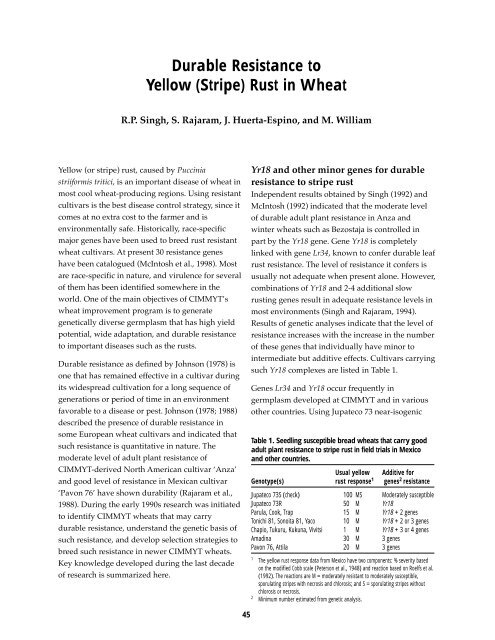Research Highlights of the CIMMYT Wheat Program 1999-2000
Research Highlights of the CIMMYT Wheat Program 1999-2000
Research Highlights of the CIMMYT Wheat Program 1999-2000
You also want an ePaper? Increase the reach of your titles
YUMPU automatically turns print PDFs into web optimized ePapers that Google loves.
Durable Resistance to<br />
Yellow (Stripe) Rust in <strong>Wheat</strong><br />
R.P. Singh, S. Rajaram, J. Huerta-Espino, and M. William<br />
Yellow (or stripe) rust, caused by Puccinia<br />
striiformis tritici, is an important disease <strong>of</strong> wheat in<br />
most cool wheat-producing regions. Using resistant<br />
cultivars is <strong>the</strong> best disease control strategy, since it<br />
comes at no extra cost to <strong>the</strong> farmer and is<br />
environmentally safe. Historically, race-specific<br />
major genes have been used to breed rust resistant<br />
wheat cultivars. At present 30 resistance genes<br />
have been catalogued (McIntosh et al., 1998). Most<br />
are race-specific in nature, and virulence for several<br />
<strong>of</strong> <strong>the</strong>m has been identified somewhere in <strong>the</strong><br />
world. One <strong>of</strong> <strong>the</strong> main objectives <strong>of</strong> <strong>CIMMYT</strong>’s<br />
wheat improvement program is to generate<br />
genetically diverse germplasm that has high yield<br />
potential, wide adaptation, and durable resistance<br />
to important diseases such as <strong>the</strong> rusts.<br />
Durable resistance as defined by Johnson (1978) is<br />
one that has remained effective in a cultivar during<br />
its widespread cultivation for a long sequence <strong>of</strong><br />
generations or period <strong>of</strong> time in an environment<br />
favorable to a disease or pest. Johnson (1978; 1988)<br />
described <strong>the</strong> presence <strong>of</strong> durable resistance in<br />
some European wheat cultivars and indicated that<br />
such resistance is quantitative in nature. The<br />
moderate level <strong>of</strong> adult plant resistance <strong>of</strong><br />
<strong>CIMMYT</strong>-derived North American cultivar ‘Anza’<br />
and good level <strong>of</strong> resistance in Mexican cultivar<br />
‘Pavon 76’ have shown durability (Rajaram et al.,<br />
1988). During <strong>the</strong> early 1990s research was initiated<br />
to identify <strong>CIMMYT</strong> wheats that may carry<br />
durable resistance, understand <strong>the</strong> genetic basis <strong>of</strong><br />
such resistance, and develop selection strategies to<br />
breed such resistance in newer <strong>CIMMYT</strong> wheats.<br />
Key knowledge developed during <strong>the</strong> last decade<br />
<strong>of</strong> research is summarized here.<br />
Yr18 and o<strong>the</strong>r minor genes for durable<br />
resistance to stripe rust<br />
Independent results obtained by Singh (1992) and<br />
McIntosh (1992) indicated that <strong>the</strong> moderate level<br />
<strong>of</strong> durable adult plant resistance in Anza and<br />
winter wheats such as Bezostaja is controlled in<br />
part by <strong>the</strong> Yr18 gene. Gene Yr18 is completely<br />
linked with gene Lr34, known to confer durable leaf<br />
rust resistance. The level <strong>of</strong> resistance it confers is<br />
usually not adequate when present alone. However,<br />
combinations <strong>of</strong> Yr18 and 2-4 additional slow<br />
rusting genes result in adequate resistance levels in<br />
most environments (Singh and Rajaram, 1994).<br />
Results <strong>of</strong> genetic analyses indicate that <strong>the</strong> level <strong>of</strong><br />
resistance increases with <strong>the</strong> increase in <strong>the</strong> number<br />
<strong>of</strong> <strong>the</strong>se genes that individually have minor to<br />
intermediate but additive effects. Cultivars carrying<br />
such Yr18 complexes are listed in Table 1.<br />
Genes Lr34 and Yr18 occur frequently in<br />
germplasm developed at <strong>CIMMYT</strong> and in various<br />
o<strong>the</strong>r countries. Using Jupateco 73 near-isogenic<br />
Table 1. Seedling susceptible bread wheats that carry good<br />
adult plant resistance to stripe rust in field trials in Mexico<br />
and o<strong>the</strong>r countries.<br />
Usual yellow Additive for<br />
Genotype(s) rust response 1 genes 2 resistance<br />
Jupateco 73S (check) 100 MS Moderately susceptible<br />
Jupateco 73R 50 M Yr18<br />
Parula, Cook, Trap 15 M Yr18 + 2 genes<br />
Tonichi 81, Sonoita 81, Yaco 10 M Yr18 + 2 or 3 genes<br />
Chapio, Tukuru, Kukuna, Vivitsi 1 M Yr18 + 3 or 4 genes<br />
Amadina 30 M 3 genes<br />
Pavon 76, Attila 20 M 3 genes<br />
1<br />
The yellow rust response data from Mexico have two components: % severity based<br />
on <strong>the</strong> modified Cobb scale (Peterson et al., 1948) and reaction based on Roelfs et al.<br />
(1992). The reactions are M = moderately resistant to moderately susceptible,<br />
sporulating stripes with necrosis and chlorosis; and S = sporulating stripes without<br />
chlorosis or necrosis.<br />
2<br />
Minimum number estimated from genetic analysis.<br />
45

















